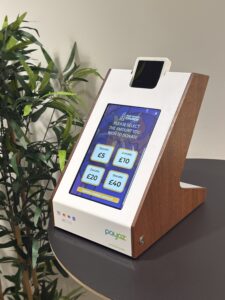For many church leaders, the idea of introducing contactless giving can feel a little overwhelming. It sounds technical, expensive, and perhaps even unnecessary if the offering plate has “worked just fine” for decades. But the reality is that the way people handle money has shifted dramatically in recent years, and churches that don’t adapt risk being left behind.
In the UK, cash payments have fallen sharply. According to UK Finance, only 12% of all payments in 2022 were made in cash, compared to more than 50% just a decade earlier (UK Finance). At the same time, contactless transactions have surged, making up 38% of all payments in 2022. In simple terms: when members of your congregation arrive on a Sunday morning, many of them will have cards or phones in their pockets—but no coins or notes.
Recognising this doesn’t mean abandoning tradition. Passing the collection plate still has spiritual and symbolic value, but offering a contactless option ensures that everyone who wants to give has the chance to do so. It’s about removing barriers, not replacing practices.
The first step in moving towards contactless giving is choosing the right device. While it’s possible to use a standard card reader, churches often find purpose-
built donation equipment far more effective. These systems are designed to feel appropriate in a place of worship; they can display your church’s logo or fundraising appeal, and they often include features such as Gift Aid. In fact, data shows that when contactless devices are introduced, giving doesn’t just stay steady—it increases. Many churches have found that the average digital donation was nearly three times higher than the average cash gift. A recent report carried out (at the national level) amongst churches reported that the average cash donation is just £3.80 compared to £11.79 for contactless giving.
Once the equipment is in place, the next step is setup—and here’s the encouraging news: it’s much simpler than it sounds. Payaz offers guides and support for you. It’s also possible to enable Gift Aid collection, which can add 25% to eligible donations without costing the donor anything extra.
Communication is the next crucial piece. A contactless device tucked away in the corner may go unnoticed. It’s far better to explain the new option during the offering time in a Sunday service, mention it in church notices and newsletters, and put up a simple sign such as: “Forgot cash? Tap here to give.” Transparency matters too: let your members know this isn’t about replacing cash giving, but about making generosity possible for everyone, regardless of how they pay for things day to day.
Training a few volunteers is also a good idea. Even though the devices are designed to be intuitive, having a couple of stewards or welcome team members who can answer questions will help put people at ease, especially those who are less confident with technology. In most cases, it only takes a quick demonstration for someone to understand how to use the system.
Finally, once the device is in use, take time to review and celebrate. Look at how giving has changed—are donations more consistent, are people giving larger amounts, or are more members participating? Share these results with the congregation so they can see the positive impact of adopting new technology. And don’t forget, a contactless device isn’t only for Sunday mornings. Many churches take them to coffee mornings, community events, or concerts, ensuring people can respond generously whenever they feel moved to give.
Introducing contactless giving is less about technology and more about accessibility. It allows churches to remain relevant in a world where money habits are changing, and it ensures no one is excluded from participating in the offering. With the right preparation and communication, the transition can be smooth, uplifting, and—most importantly—fruitful for the mission of the church.

